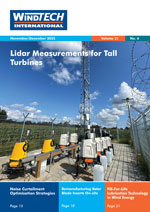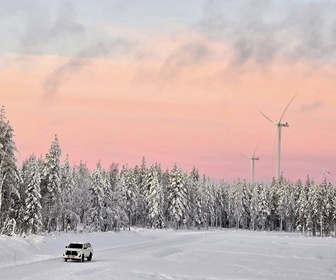- Category: Articles
 The ever-increasing strain on the traditional exploration of natural resources to provide for the worldwide demand for energy is paving the way for the wind turbine sector. We are seeing a dramatic increase in the number and size of wind turbines, producing more watts by the day. Our sector has no shortage of technological needs, but no shortage of creative minds either. Nowadays, commercial and academic institutions are reaping the benefits of joint developments. One of many exciting new developments combines the hands-on knowledge of wind turbine mechanics with photosensor technology. This article details a reliable and accurate method for measuring angular velocities, rotor blade pitch angles and the perpendicularity of individual rotor blades using vision technology. The necessary technology is packaged into a commercial service for quick and cost-effective monitoring.
The ever-increasing strain on the traditional exploration of natural resources to provide for the worldwide demand for energy is paving the way for the wind turbine sector. We are seeing a dramatic increase in the number and size of wind turbines, producing more watts by the day. Our sector has no shortage of technological needs, but no shortage of creative minds either. Nowadays, commercial and academic institutions are reaping the benefits of joint developments. One of many exciting new developments combines the hands-on knowledge of wind turbine mechanics with photosensor technology. This article details a reliable and accurate method for measuring angular velocities, rotor blade pitch angles and the perpendicularity of individual rotor blades using vision technology. The necessary technology is packaged into a commercial service for quick and cost-effective monitoring.- Category: Articles
 Various technical solutions are available for condition monitoring (CM) of wind farms. The technical and economic benefits of CM systems are the subject of debate between manufacturers and operators. Manufacturers state that CM systems lower operation costs via optimised maintenance scheduling and resource management. Operators are keen for the techno-economic benefits to be demonstrated before they switch from time-based maintenance to condition-based maintenance. In particular, the merits of monitoring individual sub-components are unclear. This article presents a method that has been developed to estimate the techno-economic benefits of individual wind farm CM options based on a combination of industry experience and publicly available data.
Various technical solutions are available for condition monitoring (CM) of wind farms. The technical and economic benefits of CM systems are the subject of debate between manufacturers and operators. Manufacturers state that CM systems lower operation costs via optimised maintenance scheduling and resource management. Operators are keen for the techno-economic benefits to be demonstrated before they switch from time-based maintenance to condition-based maintenance. In particular, the merits of monitoring individual sub-components are unclear. This article presents a method that has been developed to estimate the techno-economic benefits of individual wind farm CM options based on a combination of industry experience and publicly available data.- Category: Articles
A New Technology
 A growing concern relating to propeller-driven wind turbines is that this technology is incapable of satisfying the long-term requirements for wind harvesting without having severe economic and environmental consequences. A new and more efficient wind harvesting methodology is needed - now.
A growing concern relating to propeller-driven wind turbines is that this technology is incapable of satisfying the long-term requirements for wind harvesting without having severe economic and environmental consequences. A new and more efficient wind harvesting methodology is needed - now.By Gene R. Kelley, Founder and Chief Executive Officer, W2 Energy Development Corporation, USA
- Category: Articles
Applying Advanced Simulation Technologies to Master Wind Turbine Acoustics
 The large physical size and characteristic acoustic radiation of wind turbines make it a real challenge to accurately simulate wind turbine acoustics early in development. A wind turbine manufacturer and LMS Engineering Services have joined forces to build a hybrid vibro-acoustic simulation model. The building and validation of the wind turbine model through operational measurements carried out 100 metres above the ground are described in this article.
The large physical size and characteristic acoustic radiation of wind turbines make it a real challenge to accurately simulate wind turbine acoustics early in development. A wind turbine manufacturer and LMS Engineering Services have joined forces to build a hybrid vibro-acoustic simulation model. The building and validation of the wind turbine model through operational measurements carried out 100 metres above the ground are described in this article.By Wim Hendrickx, LMS International, Belgium
- Category: Articles
Measurement System Specialists Team with Algorithm and Analysis Experts
 Wind turbine individual pitch control (IPC) based on measures of rotor load offers substantial reduction in blade fatigue load and significant knock-on benefits to the rest of the turbine structure. The load reduction can be exploited through lighter, cheaper blades and hubs or, where fatigue is the design driver, fitting larger rotors to existing turbine structures.
Wind turbine individual pitch control (IPC) based on measures of rotor load offers substantial reduction in blade fatigue load and significant knock-on benefits to the rest of the turbine structure. The load reduction can be exploited through lighter, cheaper blades and hubs or, where fatigue is the design driver, fitting larger rotors to existing turbine structures.By Ervin Bossanyi, Garrad Hassan, and Mark Volanthen, Insensys, UK
.- Category: Articles
Taking Meteorological Predictability into Account when Choosing Sites
By Anna Hilden, FRONTWEATHER, Denmark
- Category: Articles
Dutch Company Launches Large-Scale Deepwater Wind Turbine in Italy
 Placing wind farms far from the coast addresses controversial questions of negative visual impact that often prevent siting of onshore farms. At the same time, winds offshore are stronger and of better quality than onshore, where they suffer from turbulence from contours in the landscape and large man-made structures.? Until now, the only wind farms built offshore have been in shallow waters, typically around 20 metres in depth and often close to the coast.? However, Dutch firm Blue H Technologies BV has come up with a solution, adapted from the oil and gas industry, that allows wind farms to be built in much deeper water, far from the coast, opening up tremendous new possibilities for the wind industry to harvest wind from sea areas that had not been accessible previously.
Placing wind farms far from the coast addresses controversial questions of negative visual impact that often prevent siting of onshore farms. At the same time, winds offshore are stronger and of better quality than onshore, where they suffer from turbulence from contours in the landscape and large man-made structures.? Until now, the only wind farms built offshore have been in shallow waters, typically around 20 metres in depth and often close to the coast.? However, Dutch firm Blue H Technologies BV has come up with a solution, adapted from the oil and gas industry, that allows wind farms to be built in much deeper water, far from the coast, opening up tremendous new possibilities for the wind industry to harvest wind from sea areas that had not been accessible previously.Neal Bastick, Chief Executive Officer, Blue H Technologies BV, The Netherlands










